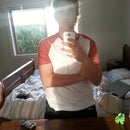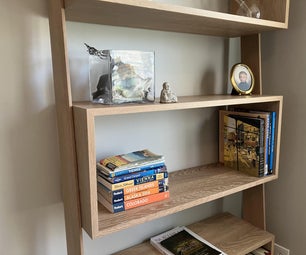Introduction: Multi-purpose Entertainment Unit
1. I emailed my cutting list to the supplier and using a table saw they cut it to the precise measurements. I dry fitted my unit.
4. I then transported my wood to school and gave it a light sanding. Using 120 grit sandpaper I lightly sanded the plywood.
5. I joined the veneer using painters tape to create the width that I needed, I overlapped the veneer by 2mm so you wouldn't see the join. When marking I used a metre rule, pencil, square and scissors. I cut the veneer oversize by 15mm each size in case of cracks forming on the edges.This gave me the best possible seamless join.
6. then using an iron i applied my veneer. I put the iron on the 3rd hottest setting and began to iron my pre-glued veneer on with a piece of paper between the veneer and iron for a tutorial on applying http://www.wikihow.com/Apply-Wood-Veneer veneer go here. I then used a Stanley knife to cut the over hang off. i also used a veneer scraper to remove the visible join.
Step 1:
7. For the drawer I marked the pieces and then asked my teacher to cut them out on the drawer. After that had been done I dried fit them together to make sure everything fits together. When marking out the drawer I used a rule, square, centre punch, hammer and a pencil.
8. For the prepping I first cut the melamine edging to size and ironed it on trimming and sanding of overhang. I then used the drill press to drill my holes. I used 40mm screws with a diameter of 5mm. For by base I used a 5mm drill bit and then for the sides a used a 4mm drill bit so the screw could grip.
9. I drilled my sides using a drill press with a 4mm drill bit and for the base I used a 5mm drill bit.
10. After pre-drilling I used a power drill and a counter sinking bit to counter sink specific holes.
11. When assembling I clamped the frame together using sash clamps and then screwing with a power drill. When screwing the base I flipped it upside down clamping the frame onto the base and began to screw.
Step 2:
11. When assembling I clamped the frame together using sash clamps and then screwing with a power drill. When screwing the base I flipped it upside down clamping the frame onto the base and began to screw.
12. I then dry fitted my whole draw.
13. I then was ready to start domino-ing my joints, I used a domino 6mm wide and 30mm long, I adjusted the settings accordingly and began to domino.
14. I then was ready to start domino-ing my joints, I used a domino 6mm wide and 30mm long, I adjusted the settings accordingly and began to domino.
15. When domino-ing the edges I used quick grip clamps to clamp them into place and began to domino, when domino-ing the faces that were within a 12.5mm range from the edge I turned the piece adjacent to the edge and clamped it down so I could domino without slipping, but when domino-ing a face that was out of that reach I had to mark where the piece was and then flip so it was laying down so it could provide support when domino-ing.
16. I the dry fitted my whole unit together.
17. I then sanded my drawer pieces before gluing.
Step 3:
20. I cut the drawer separate from the base using the table saw. When all of my drawer components were ready to glue I began gluing using sash clamps and f clamps, wiping excess glue off with some wet cotton wool. I started with the frame (sides top and bottom) and then glued my backing with my beading.
21. After my glue had finished drying I began to fit my rails on. I used a 16mm long screw 5mm wide. My setup contained a 2 spacers, a height spacer, a depth spacer and a clamp. I then screwed my rails in the appropriate holes, using a power drill.
22. After the rails were screwed on I began to screw the front drawer plate on. Using a rule square and pencil I allied my drawer cavity in the centre of the front plate. Using quick grips I clamped and held everything on position. I used a 4mm in diameter drill bit and a piece of tape to mark the depth to pre-drill. Before pre-drilling I marked 3 screw spots on the inside front piece of the draw cavity. I began to pre-drill. After I pre-drilled I used a 25mm long by 5mm screw and screwed the cavity to the front plate.
Step 4:
23. I then glued my base, book divider and backing using sash clamps, a square, PVA glue and wet cotton wool.
24. After my drawer was completed I started to make my stools, I marked them out using a rule, square and pencil, I then cut them on the table saw.
25. I then domino jointed the stools I used a 30mm by 6mm domino and used two dominos at each join. I dominoes both of my stools.
26. I then dry fitted them and confirmed that they successfully fit in the unit. After that I cut a brace on the table saw for the stools.
27. I then glued the stools. I used sash clamps and F clamps to provide good grip. I used the brace to keep them square and I used a square to make sure that they were square. I also used wet cotton wool to wipe excess glue.
Step 5:
28. After the stools I began to manufacture the shelves. I started manufacturing the shelves by marking where the screws and dowel are going to go on the back of the backing board and shelves using a pencil, square and rule.
29. I then centre punched all of the markings and began to drill the backing board. For the dowel I bought 9mm dowel so for a tight fit which will prevent sagging of the shelf. I began using the power drill to drill the hole with a 9mm drill bit for a tight fit. I repeated this for the other shelf. Using a square to make sure I was drilling straight.
30. Then using a magazine sheet, thin ply and a hydraulic jack I lined the holes up. I used a level to make sure
everything was level. I raised and adjusted the jack until everything was in place. I then marked the 9mm drill bit with some painters tape.
31. when everything was in place I started to dill through my backing using that hole as a guide and the tape as a guide. I required someone to hold the shelf in place while I drill in case of any movements. After that I then inserted random lengths of dowel to make it more stable for when I drilled my 4mm holes for the screws.
32. I then measured the dowel out using a pencil and cut it on the band saw. Repeating 4 times.
33. I put PVA glue in the dowel hole and on the surface edge and fed the dowel holes in. I put the shelf in place again using the jig to make sure everything is level.
34. Then using the power drill I screwed in my screws, making sure everything was level all the time.
Step 6:
35. After marking the holes using a square, rule and a pencil I began using a power drill with a 60mm (diameter) whole saw I drilled 2 holes just above the shelves.
36. then using sash clamps, F clamps and gravity clamps I clamped my TV top to my backing and book divider. I used cotton wool to wipe excess glue off.
37. Using a rule, square and pencil I marked out were by brackets had to go and then I screwed them in with a power drill.
38. After all of my gluing was done for my project I began to screw my hinges in. using a square, pencil and rule I marked were my hinges had to go and then with a power drill I screwed them in.
39. Using the power drill I screwed the castors on each corner. I placed a washer in between the screw head and the castors plate.
40. I then started to sand my unit and get all of the dirty marks off. I used 120 grit sand paper and then moved to a 230 grit sand paper.
41. I then used a cloth and applied 2 coats of wax on the whole unit.










